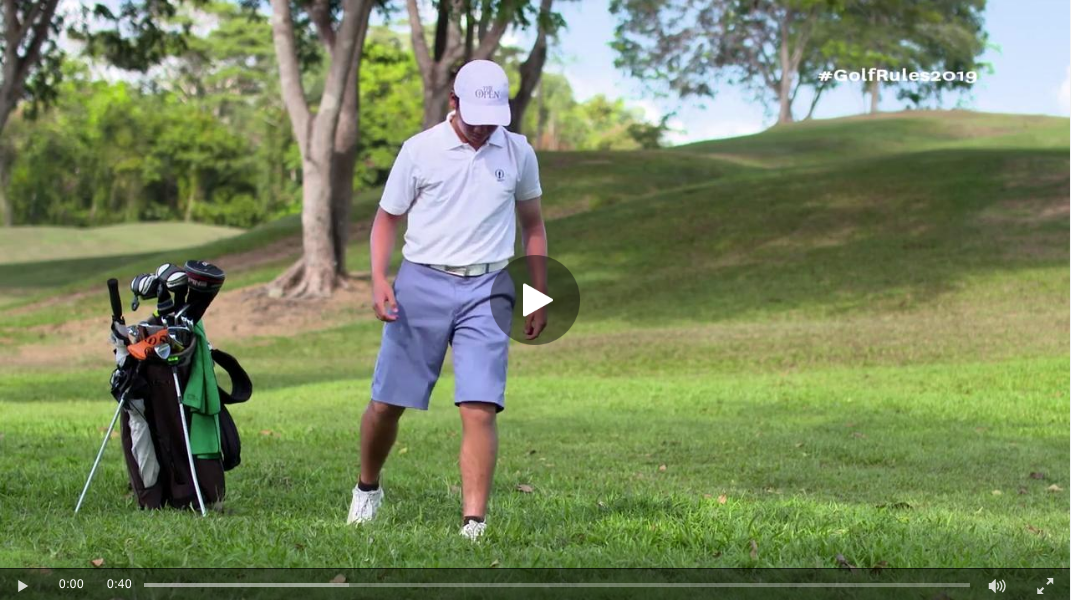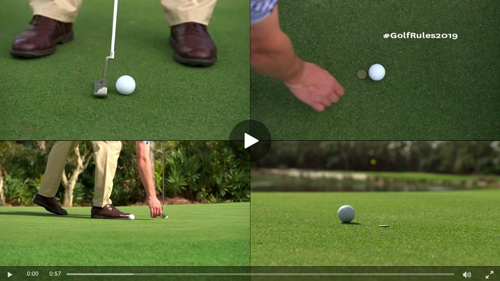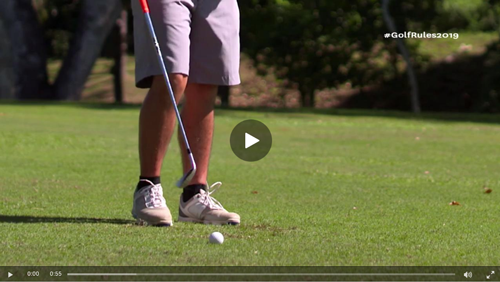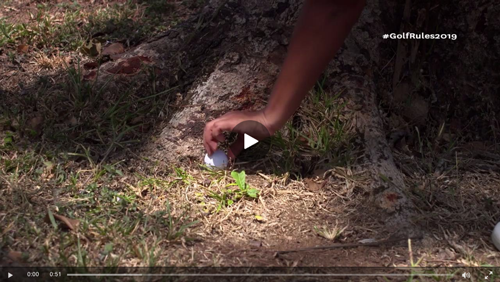Ball at Rest
2019 Golf Rule Changes
Become comfortable with the rule changes to help you this season.
Topic 1 | Ball at Rest
Rule – Ball Moved During Search
There will be no penalty for moving your golf ball during search.
2019 Rule: Under Rule 7.4, if a player accidentally moves his or her ball while searching for it:
- The player will get no penalty for causing it to move, and
- The ball will always be replaced; if the exact spot is not known, the player will replace the ball on the estimated original spot (including on, under or against any attached natural or man-made objects which the ball had been at rest under or against).
Reasons for Change:
- A fundamental principle of golf is to play the ball as it lies; so the Rules should help the player to find his or her ball and play it from the spot where it was at rest.
- Players often need to probe in grass, bushes, leaves and other conditions to look for a hidden ball, and such reasonable acts create an inherent risk of moving the ball.
- The current Rules allow both an opponent in match play, and other players in stroke play, to help search for the player’s ball without risk of penalty if they accidentally move the player’s ball; outside persons such as spectators are allowed to help search as well.
- It is inconsistent to encourage everyone but the player or his or her caddie (or partner) to look for the ball, and this creates an odd incentive for the player to hold back and let others search.
Check out the VIDEO:
No Penalty for accidentally moving your ball or ball-marker on the putting green.
2019 Rule: Under Rule 13.1d, there will no longer be a penalty if a player (or opponent) accidentally causes the player’s ball to move on the putting green.
- The substance of this Rule change has already been implemented as of January 1, 2017 by authorizing Committees to adopt a Local Rule that eliminates the penalty for accidentally moving a ball on the putting green.
Reasons for Change:
- The shape, slope and condition of many putting greens today increase the chances that a ball at rest on the putting green might move, and it can be difficult to determine whether a player caused the ball to move or whether the ball was moved by wind or other natural causes.
- When a ball moves while the player is doing nothing more than taking normal actions to prepare for a stroke, it can seem unfair for the player to be penalized.
- Most “ball moved” situations occur on the putting green, involve minimal movement of the ball, frequently occur when the player is taking reasonable actions to prepare for a stroke and the ball can be easily replaced.
- These considerations are not the same when the ball lies off the putting green, and so the penalty will continue to apply (with exceptions, such as accidentally moving a ball during search) to a player or opponent in those circumstances to reinforce the principle that the ball should be played as it lies and that players should continue to exercise care when near to a ball in play.
Check out the VIDEO:
Rule – Standard for Deciding Why a Ball MovedNew standard to determine if you caused your ball to move.
2019 Rule: Under Rule 9.2, the “known or virtually certain” standard (meaning at least 95% likely) will apply to all questions of fact about why a ball at rest moved:
A player, opponent or outside influence will be found to have caused the ball to move if the player, opponent or outside influence was known or virtually certain to have caused it to move; otherwise it will be assumed that natural forces caused it to move.
Reasons for Change:
The weight of the evidence test is often difficult to apply in ball moved situations:
- Many competing factors need to be balanced, such as what the player did near the ball, the lapse of time before the ball moved, the lie of the ball, the slope and other course conditions near the ball and the presence of wind or weather conditions, and
- There is no prescribed way of prioritizing or balancing these factors.
The “known or virtually certain” standard will be simpler to apply because it will eliminate most “close calls” where it is hard to know for sure why the ball moved.
This Rule change also means that only the single standard of “known or virtually certain” will be used for all ball moved questions, rather than the situation under the current Rules where different standards apply in deciding whether an outside influence moved a ball or whether the player or opponent did so.
Check out the VIDEO:
Rule – Replacing Ball When Original Spot is Not Known
When the original location of your ball is not known, replace it on its estimated spot.
2019 Rule: Under Rule 14.2c, in that same situation:
- The ball will always be placed on a spot rather than being dropped.
- If the exact original spot is not known, the player will be required to replace the ball on its estimated spot (including on, under or against any attached natural objects that the ball had been at rest on, under or against).
Reasons for Change:
A fundamental principle of golf is to play the ball as it lies; so this should mean that, when a ball at rest is moved, it should be returned to and played from its original spot or as close to that original spot as possible.
When a player marks the ball’s spot with a ball-marker before lifting the ball, the original spot is known and the ball is replaced on the marked spot.
But when a ball is accidentally moved, the player may not know the exact original spot:
- Currently, if the ball was at rest anywhere off the putting green, the player must drop the ball as near as possible to its estimated spot and play the ball from where it comes to rest (unless it rolls to where it must be re-dropped under Rule 20-2c).
- This means that the ball will often not be played from the estimated spot, as the dropped ball is allowed to roll as much as two-club lengths away from that spot.
- It also means that the ball may end up being played from a better or worse lie than the original lie (such as when the original spot was in the rough and the dropped ball comes to rest in the fairway, or vice versa; or when the ball had been at rest in deep grass and the dropped ball comes to rest on top of the grass).
Requiring the player to replace the ball on the estimated spot (including being required to replace the ball on, under or against any fixed or growing things it had been at rest on, under or against) will help make sure the ball is played from as close as possible to its original spot and from the same or almost the same lie.
Replacing the ball on its estimated spot also applies when the player does not know the exact original spot of a ball that was lifted or moved on the putting green, and so the same procedure will apply throughout the course.
Check out the VIDEO:



